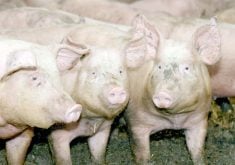People with a lifetime invested in their cattle may be facing the toughest period of their lives this fall.
BSE-restricted trade leaves commercial and purebred breeders musing about their ability to hang on for another year as they face soft calf sales this fall.
For Scott Pahl, the new president of the Canadian Hereford Association, this has been the worst period of his life as a beef producer.
Running Hereford and Angus purebred units of 100 cows each, as well as a 350 head commercial herd near Medicine Hat, Alta., he has accepted the added responsibility of leading Canada’s oldest breed association.
Read Also

The Western Producer Livestock Report – October 2, 2025
Western Producer Livestock Report for October 2, 2025. See U.S. & Canadian hog prices, Canadian bison & lamb market data and sale insight.
The ongoing fallout from BSE and closed international borders has forced producers into survival mode. As the cow-calf sector ponders its future, the fortunes of the seedstock business are directly affected if people decide to seek lower priced bulls or not replace breeding animals this season.
“Agriculture has been a tough go over the years but there were always options,” Pahl said in an interview.
But now, “on the purebred end, our options are very limited.”
His family has traditionally held an annual fall sale with two other Hereford operations. Like other purebred breeders, they must decide whether to hold a production sale this year or wait until trade normalizes and hope prices climb.
Last year, purebred producers offered financing, low cost boarding and in some cases, culled more heavily than normal, retaining only the best males as bulls and turning the rest into steers.
Pahl’s family normally sold about 40 yearling bulls as breeding stock. That was not the case this year.
“We kept only our top, top end because we know it’s going to be difficult to move what we’ve got,” he said.
“That’s one positive. The guys who are still buying are probably buying the best end bulls for probably the middle to bottom end dollar.”
As president, Pahl must help his association develop survival plans that could include selling Hereford branded beef if a reliable slaughter facility could be found.
In addition, in recent years, more time is devoted to building performance records necessary to prove the value of breeding animals and the qualities they pass on to offspring.
Further technology will be added to guarantee the credibility of pedigrees. Starting in 2006, the DNA profile on all Hereford sires must be on file with the association before the calf can be registered.
That information could be valuable once live trade resumes.
However Pahl said breeding stock is likely the last to be allowed out of the country even though such restrictions are unnecessary. Purebred animals are registered with their associations and through the Canadian Cattle Identification Agency.
“They are very easy to track because they have that ID right from a baby. They’re tattooed and registered as papered cattle.”
Another challenge for the breed is rebuilding flagging animal registrations.
From the high flying years two decades ago, when more than 40,000 head were registered annually as purebred Herefords, numbers have dropped to less than half that amount in 2003. Herefords dropped in popularity partly because of a perception they were not efficient in the feedlot.
However, Pahl points out most crossbreds have a Hereford background.
“Our biggest loss over the years was not taking credit for the crossbreeds,” he said.
Promoters also became complacent and got used to sitting as the most popular breed in Canada. Other breeds, including Angus and European animals, bumped them off the pedestal.
“By the time we realized that we had to step up to plate and be more active and do the things our customers needed, we were behind the eight ball,” Pahl said.

















